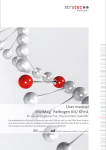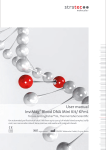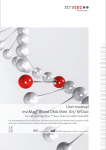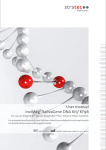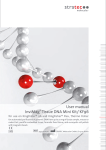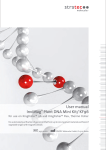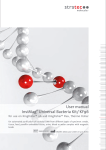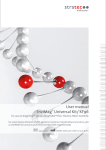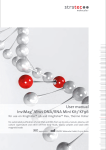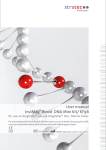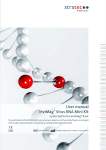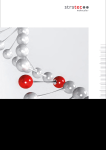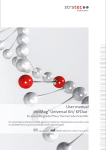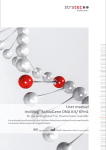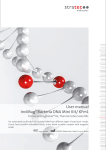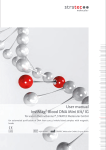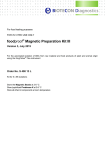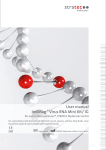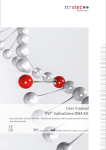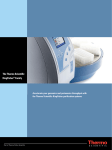Download InviMag Virus DNA/RNA Mini Kit/ KFmL User manual
Transcript
User manual InviMag® Virus DNA/RNA Mini Kit/ KFmL for use on KingFisher®mL, Thermo Fisher Scientific for automated purification of viral DNA and RNA from up to 200 µl serum, plasma, cell culture supernatant and other cell-free body fluids, biopsy samples and swabs with magnetic beads IVD REF 2441150x00 STRATEC Molecular GmbH, D-13125 Berlin Instruction InviMag® Virus DNA/RNA Mini Kit/ KFmL The InviMag® Virus DNA/RNA Mini Kit/ KFmL is the ideal tool using a combination of RTP® technology and InviMag® technology for simultaneous isolation of high quality viral DNA and RNA from human and animal serum and plasma samples, cerebrospinal fluid, cell culture supernatants and other cell-free body fluids, like urine as well as from swabs or tissue biopsies for in vitro diagnostic purposes. Fresh or frozen plasma or serum from blood treated with anticoagulants like EDTA or citrate, but not with heparin. The customer convenient RTP® technology simplifies the process handling, reduces the handling steps with infectious material and allows process monitoring. Due to the high purity, the isolated viral DNA and RNA is ready-to-use for a broad panel of downstream applications or can be stored at – 80°C for subsequent use. The kit is neither suitable for isolation of viral DNA or RNA from whole blood or blood stains, nor for isolation of RNA or DNA from bacteria, fungi, plants. IVD Compliance with EU Directive 98/79/EC on in vitro medical devices. Not for in vitro diagnostic use in countries where the EU Directive 98/79/EC on in vitro medical devices is not recognized. ® ® ® Trademarks: InviMag , Invisorb , RTP . Registered marks, trademarks, etc. used in this document, even when not specifically marked as such, are not to be considered unprotected by law. ® The Invisorb technology is covered by patents and patent applications: US 6,110363, US 6,043,354, US 6,037,465, EP 0880535, WO 9728171, WO 9534569, EP 0765335, DE 19506887, DE 10041825.2, WO 0034463. ® ® ® InviMag , Invisorb and RTP are registered trademarks of STRATEC Biomedical AG. The PCR process is covered by US Patents 4,683,195, and 4,683,202 and foreign equivalents owned by Hoffmann-La Roche AG. © 2015 STRATEC Molecular, all rights reserved. 1 ® InviMag Virus DNA/RNA Mini Kit/ KFmL 0515 Content Kit contents of InviMag® Virus DNA/RNA Mini Kit/ KFmL 3 Kit contents of InviMag® Virus DNA/RNA Mini Kit/ KFmL/ w/o plastic 4 Symbols 5 Storage 5 Quality control 5 Intended use 6 Product use limitation 6 Internal control (IC) / Extraction control 6 Safety information 7 Product characteristic of the InviMag® Virus DNA/RNA Mini Kit/ KFmL 8 Sampling and storage of starting material 8 Principle and procedure 9 Yield and quality of viral DNA and / or viral RNA 10 Important notes 10 Reagents and equipment to be supplied by user 10 Preparing reagents and buffers 11 Important indications 11 Scheme of the InviMag® Virus DNA/RNA Mini Kit/ KFmL 12 Protocol 1: Simultaneous isolation of total nucleic acids (viral DNA and RNA) from cell free body fluids (serum, plasma, CSF, synovial, urine) 13 Protocol 2: Simultaneous isolation of total nucleic acids (viral DNA and RNA) from cell culture supernatant 13 Protocol 3: Simultaneous isolation of total nucleic acids (viral DNA and RNA) from swabs or 200 µl rinse liquid 14 Protocol 4 : Simultaneous isolation of total nucleic acids (viral DNA and RNA) from tissue biopsy 14 Starting a run on the KFmL instrument 15 The following steps will run automatically on the KingFisher mL 16 For self-programming of the KingFisher mL system 17 Troubleshooting 19 Appendix 20 General notes on handling DNA 21 General notes on handling viral RNA 22 Ordering information 23 2 ® InviMag Virus DNA/RNA Mini Kit/ KFmL 0515 Kit contents of InviMag® Virus DNA/RNA Mini Kit/ KFmL Store the MAP Solution A at 2-8°C. Store all other kit components at room temperature. Catalogue No. Extraction Tubes MAP Solution A Binding Solution (fill with 99.7% Isopropanol) Wash Buffer R1 15 extractions 75 extractions 300 extractions 2441150100 2441150200 2441150400 15 75 6 x 50 0.5 ml 2 x 1 ml 7 ml empty bottle (final volume 8 ml) empty bottle (final volume 40 ml) empty bottle (final volume 140 ml) 10 ml 2 x 20 ml 2 x 80 ml (final volume 20 ml) (final volume 2 x 40 ml) (final volume 2 x 160 ml) 12 ml 30 ml 3 x 40 ml (final volume 60 ml) (final volume 150 ml) (final volume 3 x 200 ml) 2 ml 15 ml 60 ml KingFisher mL Tip Combs 3 15 60 KingFisher mL Tube Strips 15 5 x 15 300 Elution Tubes 15 5 x 15 6 x 50 Manual 1 1 1 Wash Buffer R2 Elution Buffer R Initial steps Fill 8 ml 99.7% Isopropanol (molecular biologic grade) into the empty bottle Fill 40 ml 99.7% Isopropanol (molecular biologic grade) into the empty bottle Fill 140 ml 99.7% Isopropanol (molecular biologic grade) into the empty bottle Add 10 ml of 96-100% ethanol to the bottle Wash Buffer R1, mix thoroughly and always keep the bottle firmly closed! Add 20 ml of 96-100% ethanol to the bottle Wash Buffer R1, mix thoroughly and always keep the bottle firmly closed! Add 80 ml of 96-100% ethanol to each bottle Wash Buffer R1, mix thoroughly and always keep the bottle firmly closed! Add 48 ml of 96-100% ethanol to the bottle Wash Buffer R2, mix thoroughly and always keep the bottle firmly closed! Add 120 ml of 96-100% ethanol to the bottle Wash Buffer R2 , mix thoroughly and always keep the bottle firmly closed! Add 160 ml of 96-100% ethanol to each bottle Wash Buffer R2, mix thoroughly and always keep the bottle firmly closed! 3 ® InviMag Virus DNA/RNA Mini Kit/ KFmL 0515 Kit contents of InviMag® Virus DNA/RNA Mini Kit/ KFmL w/o plastic Store the MAP Solution A at 2-8°C. Store all other kit components at room temperature. 15 extractions 75 extractions 300 extractions 2441150150 2441150250 2441150450 15 75 6 x 50 MAP Solution A 0.5 ml 2 x 1 ml 7 ml Binding Solution (fill with 98-100% Isopropanol) empty bottle (final volume 8 ml) empty bottle (final volume 40 ml) empty bottle (final volume 140 ml) Catalogue No. Extraction Tubes Wash Buffer R1 10 ml 2 x 20 ml 2 x 80 ml (final volume 20 ml) (final volume 2 x 40 ml) (final volume 2 x 160 ml) 12 ml 30 ml 3 x 40 ml (final volume 60 ml) (final volume 150 ml) (final volume 3 x 200 ml) 2 ml 15 ml 60 ml Elution Tubes 15 5 x 15 6 x 50 Manual 1 1 1 Wash Buffer R2 Elution Buffer R Initial steps Fill 8 ml 99.7% Isopropanol (molecular biologic grade) into the empty bottle Fill 40 ml 99.7% Isopropanol (molecular biologic grade) into the empty bottle Fill 140 ml 99.7% Isopropanol (molecular biologic grade) into the empty bottle Add 10 ml of 96-100% ethanol to the bottle Wash Buffer R1, mix thoroughly and always keep the bottle firmly closed! Add 20 ml of 96-100% ethanol to the bottle Wash Buffer R1, mix thoroughly and always keep the bottle firmly closed! Add 80 ml of 96-100% ethanol to each bottle Wash Buffer R1, mix thoroughly and always keep the bottle firmly closed! Add 48 ml of 96-100% ethanol to the bottle Wash Buffer R2, mix thoroughly and always keep the bottle firmly closed! Add 120 ml of 96-100% ethanol to the bottle Wash Buffer R2 , mix thoroughly and always keep the bottle firmly closed! Add 160 ml of 96-100% ethanol to each bottle Wash Buffer R2, mix thoroughly and always keep the bottle firmly closed! Plastic to be supplied by user (see order information) KingFisher mL Tip Combs 3 15 60 KingFisher mL Tube Strips 15 5 x 15 300 4 ® InviMag Virus DNA/RNA Mini Kit/ KFmL 0515 Symbols Lot number Catalogue number Expiry date Consult operating instructions Temperature limitation Do not reuse Storage All buffers and kit contents of the InviMag® Virus DNA/RNA Mini Kit/ KFmL, except MAP Solution A, are stable for at least 12 months. MAP Solution A is stable for at least 6 months. All buffers and kit contents of the InviMag® Virus DNA/RNA Mini Kit/ KFmL, except MAP Solution A, should be stored at room temperature (RT) MAP Solution A: should be stored at 2-8°C. Room temperature is defined as range from 15–30°C. Wash Buffer charged with ethanol should be stored at room temperature and should be appropriate sealed. If there are any precipitates visible within the provided solutions dissolve them by carefully warming up to 30°C. Quality control and product warranty STRATEC Molecular warrants the correct function of the InviMag® Virus DNA/RNA Mini Kit/ KFmL for applications as described in this manual. Purchaser must determine the suitability of the product for its particular use. Should any product fail to perform the applications as described in the manual, STRATEC Molecular will check the lot and if STRATEC Molecular investigates a problem in the lot, STRATEC Molecular will replace the product free of charge. STRATEC Molecular reserves the right to change, alter, or modify any product to enhance its performance and design at any time. In accordance with STRATEC Molecular’s ISO 9001-2000 and ISO EN 13485 certified Quality Management System the performance of all components of the InviMag® Virus DNA/RNA Mini Kit/ KFmL have been tested separately against predetermined specifications routinely on lot-tolot to ensure consistent product quality. If you have any questions or problems regarding any aspects of InviMag® Virus DNA/RNA Mini Kit/ KFmL or other STRATEC Molecular products, please do not hesitate to contact us. A copy of STRATEC Molecular’s terms and conditions can be obtained upon request or are presented at the STRATEC Molecular webpage. For technical support or further information please contact: from Germany: +49-(0)30-9489-2901/ 2910 from abroad: +49-(0)30-9489-2907 or contact your local distributor. 5 ® InviMag Virus DNA/RNA Mini Kit/ KFmL 0515 Intended use The InviMag® Virus DNA/RNA Mini Kit/ KFmL is designed for a simultaneous rapid and economical preparation of DNA and RNA from viruses from a wide range of clinical samples, using RTP®-technology, magnetic beads, and the KingFisher mL workstation. The whole process is based on a patented technology, the InviMag technology, for isolation of viral DNA and RNA by binding the nucleic acid onto magnetic particles without chaotropic buffer components. For reproducible and high yields appropriate sample storage is essential. The purified DNA / RNA is of high quality and can be used for in vitro diagnostic analysis. THE PRODUCT IS INDENTED FOR USE BY PROFESSIONALS ONLY, SUCH AS TECHNICIANS, PHYSICIANS AND BIOLOGISTS TRAINED IN MOLECULAR BIOLOGICAL TECHNIQUES. It is designed to be used with any downstream application employing enzymatic amplification or other enzymatic modifications of DNA/ RNA followed by signal detection or amplification. Any diagnostic results generated by using the sample preparation procedure in conjunction with any downstream diagnostic assay should be interpreted with regard to other clinical or laboratory findings. To minimize irregularities in diagnostic results, adequate controls for downstream applications should be used. The kit is in compliance with EU Directive 98/79/EC on in vitro medical devices. But it is not for in vitro diagnostic use in countries where the EU Directive 98/79/EC on in vitro medical devices is not recognized. Product use limitation The kit is neither validated for the isolation of genomic DNA from stool sample, dried blood stains, nor from bacteria, fungi, parasites or the purification of total RNA. The included chemicals are only useable once. Differing of starting material or flow trace may lead to inoperability; therefore neither a warranty nor guarantee in this case will be given, neither implied nor express. The user is responsible to validate the performance of the STRATEC Molecular product for any particular use. STRATEC Molecular does not provide for validation of performance characteristics of the product with respect to specific applications. STRATEC Molecular products may be used e.g.in clinical diagnostic laboratory systems conditioned upon the complete diagnostic system of the laboratory the laboratory has been validated pursuant to CLIA’ 88 regulations in the U.S. or equivalents in other countries. All products sold by STRATEC Molecular are subject to extensive quality control procedures (according to ISO 9001-2000 and ISO EN 13485) and are warranted to perform as described herein. Any problems, incidents or defects shall be reported to STRATEC Molecular immediately upon detection thereof. The chemicals and the plastic parts are for laboratory use only; they must be stored in the laboratory and must not be used for purposes other than intended. The product with its contents is unfit for consumption. Internal control (IC) / Extraction control Internal Controls (IC) from the PCR assay provider can be used as extraction controls if the fragments are longer than 100 bp. In this case they have to be added after finalization of the lysis step. Attention: don´t add directly these Internal Controls to the sample! 6 ® InviMag Virus DNA/RNA Mini Kit/ KFmL 0515 Safety information When and while working with chemicals, always wear a suitable lab coat, disposable gloves, and protective goggles! Avoid skin contact! Adhere to the legal requirements for working with biological material! For more information, please consult the appropriate material safety data sheets (MSDS). These are available online in convenient and compact PDF format at www.stratec.com for each STRATEC Molecular product and its components. If buffer bottles are damaged or leaking, WEAR GLOVES, AND PROTECTIVE GOGGLES when discarding the bottles in order to avoid any injuries. STRATEC Molecular has not tested the liquid waste generated by the InviMag® Virus DNA/RNA Mini Kit/ KFmL procedures for residual infectious materials. Contamination of the liquid waste with residual infectious materials is highly unlikely, but cannot be excluded completely. Therefore, liquid waste must be considered infectious and be handled and discarded according to local safety regulations. European Community risk and safety phrases for the components of the InviMag® Virus DNA/RNA Mini Kit/ KFmL to which they apply, are listed below as follows: Wash Buffer R1 contains guanidinthiocyanat which is an irritant. Wash Buffer and Elution Buffer R contain DEPC-treated ddH2O. DEPC is inactivated by autoclaving for 20 min. at 121°C. Proteinase K (included in the Extraction Tube ) Wash Buffer R1 danger H315-319-334-335 P280-305-351-338-310-405 danger H302-312-332-412 EUH032 P273 H319: H302: H312: H332: H412: EUH032: H315: H334: H335: P305+P351+P338: P273: P280: P310: P405: Causes serious eye irritation. Harmful if swallowed. Harmful in contact with skin. Harmful if inhaled. Harmful to aquatic life with long lasting effects. Contact with acids liberates very toxic gas. Causes skin irritation. May cause allergy or asthma symptoms or breathing difficulties if inhaled. May cause respiratory irritation. If in eyes: Rinse cautiously with water for several minutes. Remove contact lenses, if present and easy to do. Continue rinsing. Avoid release to the environment. Wear protective gloves/protective clothing/eye protection/face protection. Immediately call a POISON CENTER or doctor/physician. Store locked up. Emergency medical information can be obtained 24 hours a day from infotrac: outside of USA: in USA : 1 – 352 – 323 – 3500 1 – 800 – 535 – 5053 7 ® InviMag Virus DNA/RNA Mini Kit/ KFmL 0515 Product characteristic of the InviMag® Virus DNA/RNA Mini Kit/ KFmL Starting material Yield Time for preparation up to 200µl of fresh or frozen plasma, serum and cell free body fluids up to 200 µl cell culture supernatant up to 200µl of rinse liquid from swabs swab up to 10 mg biopsy samples sensitive recovery realizing amplification with sensitive detection assays from staring material including minimum 100 copies per ml about 20-25 min after lysis The InviMag® Virus DNA/RNA Mini Kit/ KFmL is designed for a simultaneous rapid and economical preparation of viral DNA and RNA from a wide range of clinical samples, using a combination of RTP®-technology, magnetic beads, and the KingFisher mL workstation. The isolation process is based on a patented technology, the InviMag technology, for isolation of viral RNA and DNA by binding the nucleic acid onto magnetic particles without chaotropic buffer components. The sample is lysed in an optimized lysis buffer. The lysates are transferred to the subsequent automatic purification procedure based on magnetic beads. The viral DNA and RNA bind to magnetic particles, followed by washing steps and a final elution. The procedure requires only minimal interaction by the user, allowing safe handling of potentially infectious samples. The procedure is designed to avoid sample-to-sample cross-contamination. The purified high quality viral DNA and RNA is ready-to-use for subsequent downstream applications (see below) or can be stored at -20°C for subsequent use. ○ ○ ○ RT-PCR* PCR* Real-time PCR for quantitative and qualitative virus diagnostic No toxic or hazardous chemicals like chaotropic components are used. For the isolation of viral RNA from single sample from 200 µl starting material STRATEC Molecular offers the RTP® DNA/RNA Virus Mini Kit and the Invisorb Spin Virus RNA Mini Kit. For the isolation of viral RNA using magnetic particle in high throughput format, STRATEC Molecular offers the InviMag® Virus Kits/KF96 for use on a KingFisher 96 robot. For vacuum or centrifuge based isolation of viral RNA in 96 well format on different robotic stations STRATEC Molecular offers the Invisorb® DNA Virus HTS 96 Kit and the Invisorb RNA Virus HTS 96 Kit. (See ordering information, page 21) For further information please contact: +49 (0) 30 9489 2901, 2910 in Germany and from foreign countries: +49 (0) 30 9489 2907 or call your local distributor Sampling and storage of starting material Best results are obtained using freshly extracted samples. As long as the samples are not shock frosted with liquid nitrogen or are incubated with RNase inhibitors or denaturing reagents, the viral RNA is not secured. Therefore it is essential, that samples are immediately flash frozen subsequent to the harvesting by using liquid nitrogen and are stored at -80°C. Viral RNA contained in such deep frozen samples is stable for months. Viral RNA purification should be processed as soon as possible. Samples can also be stored in the dissolved Lysis Buffer in the Extraction Tube I or II for 1 h at room temperature, overnight at 4°C, and for long-term storage at -80°C. Storage under deep frozen conditions is recommended. Serum, plasma, urine, cerebrospinal fluid or other cell-free body fluids, as well as cell culture supernatants, swabs, and stool samples can be stored on ice for 1-2 hours, for short time (up to 24 h) samples may be stored at -20°C. For long-term storage, we recommend freezing samples at -80°C. Multiple thawing and freezing cycles before isolating the viral RNA should be avoided. 8 ® InviMag Virus DNA/RNA Mini Kit/ KFmL 0515 Serum and plasma (and other cell free body fluids) Following centrifugation, plasma or serum from blood treated with anticoagulants like EDTA or citrate, but not with heparin, can be stored at 2-8°C for up to 6 hours. For long-term storage, freezing at -20°C to -80°C in aliquots is recommended. Repeated freezing and thawing cycles must be avoided because denaturation and precipitation of proteins result in a decrease of the virus titer and thereby reduce the yield of the extracted viral RNA. Occurring cryoprecipitates can be pelleted by briefly centrifuging (6.800 x g for 3 min). The cleared supernatant should be removed, without disturbing the pellet, and processed immediately. This step will not reduce viral titers. * The PCR process is covered by US Patents 4,683,195, and 4,683,202 and foreign equivalents owned by HoffmannLa Roche AG. Tissue samples (biopsy material or frozen section) Best results are obtained with fresh material or material that has been immediately flash frozen and stored at -20°C or -80°C. Repeated freezing and thawing cycles of stored samples should be avoided because this leads to a low RNA yield. Use of poor quality starting material influences the RNA yield, too. The amount of purified RNA in the RTP® DNA/ RNA Virus Mini Kits procedure using up to 20 mg tissue sample, depends on kind of starting material. The thawing process could be proceed, e.g. directly in the Extraction Tubes. Cell culture supernatants Best results are obtained with fresh material or material that has been immediately frozen and stored at -20°C or -80°C after separation of the cell culture supernatant. Repeated freezing and thawing cycles of stored samples will influence the sensitivity. Swabs The protocol works with fresh prepared swabs or rinsed liquid from swabs or mouth brushes. Best results are obtained with fresh material or material that has been immediately frozen and stored at -20°C or -80°C. STRATEC Molecular will be released of its responsibilities if other sample materials than described in the Intended Use are processed or if the sample preparation protocols are changed or modified. Principle and procedure The InviMag® Virus DNA/RNA Kit/ KFmL procedure comprises following steps: ○ lysis of the virus particles in the prefilled Extraction Tube ○ binding the viral NA to the magnetic beads ○ washing of the magnetic beads and elimination of ethanol ○ elution of the viral nucleic acids After lysis, the viral NA bind to the magnetic beads, contaminations and enzyme inhibitors are efficiently removed during the following three wash steps and high purified DNA/RNA is eluted in Elution Buffer R or water. This manual contains 4 protocols. Lysis Samples are lysed under denaturing conditions at elevated temperatures. Binding of the viral nucleic acids After adding Binding Solution and MAP Solution A to the lysate in the Extraction Tube, the nucleic acids are bound to the surface of the magnetic beads. Removing residual contaminants Contaminants are efficiently washed away using Wash Buffer R1 and R2, while the nucleic acids remain bound to the magnetic beads Elution The nucleic acids are eluted from the beads using 100 µl Elution Buffer R. The eluted nucleic acids are ready-to-use in different subsequent tests. 9 ® InviMag Virus DNA/RNA Mini Kit/ KFmL 0515 Yield and quality of viral DNA and / or viral RNA Different amplification systems vary in efficiency depending on the total amount of nucleic acid present in the reaction. Eluates derived by this kit will contain Carrier-RNA, which will greatly exceed the amount of the isolated NA. Yields of viral nucleic acids isolated from biological samples are usually low concentrated and therefore almost impossible to determine photometrically.* * Keep in mind that the Carrier-RNA (5 μg per 200 μl sample) will account for most of the present NA. The kit is suitable for downstream analysis with NAT techniques, for examples qPCR, RT qPCR, LAMP, LCR. Diagnostic assays should be performed according to the manufacturer’s instructions. The amount of purified viral NA in the InviMag® Virus DNA/RNA Mini Kit/ KFmL procedure from plasma etc., depends on the sample type, sample source, transport, storage, and age. Quantitative RT-PCR is recommended for determination of viral NA yield. * In Gel Electrophoresis and in Capillary Electrophoresis, RNA extracted with the provided kit looks like degraded cause the kit contains Carrier-RNA, this is poly A RNA in fragments of 100 up to 1000 bases. The kit is not dedicated for applications using this kind of analysis. Important notes Important points before starting a protocol Immediately upon receipt of the product, inspect the product and its components as well as the package for any apparent damages, correct quantities and quality. If there are any unconformities you have to notify STRATEC Molecular in writing with immediate effect upon inspection thereof. If buffer bottles are damaged, contact the STRATEC Molecular Technical Services or your local distributor. In case of liquid spillage, refer to “Safety Information” (see page 7). Do not use damaged kit components, since their use may lead to poor kit performance. ○ ○ ○ ○ ○ ○ ○ ○ Always change pipet tips between liquid transfers. To avoid cross-contamination, we recommend the use of aerosol-barrier pipet tips. All centrifugation steps are carried out at room temperature. When working with chemicals, always wear a suitable lab coat, disposable gloves and protective goggles. Discard contaminated gloves immediately. Do not combine components of different kit, unless the lot numbers are identical. Avoid microbial contamination of the kit reagents. To minimize the risk of infections from potentially infectious material, we recommend working under laminar air-flow until the samples are lysed. This kit should only be used by trained personnel. Reagents and equipment to be supplied by user ○ ○ ○ ○ ○ ○ ○ ○ Measuring cylinder (250 ml) Pipette and pipette tips Disposable gloves Reaction tubes (1.5 ml or 2.0 ml) ddH2O Vortexer 96–100% ethanol Isopropanol * The InviMag® Virus DNA/RNA Mini Kit/ KFmL is validated with 2-Propanol; Rotipuran >99.7%, p.a., ACS, ISO (Order no. 6752) from Carl Roth * Possible suppliers for Isopropanol: Carl Roth 2-Propanol Rotipuran >99.7%, p.a., ACS, ISO Order no. 6752 Applichem 2-Propanol für die Molekularbiologie Order no. A3928 10 Sigma 2-Propanol Order no. 59304-1L-F ® InviMag Virus DNA/RNA Mini Kit/ KFmL 0515 Preparing reagents and buffers 15 viral NA-extractions: Fill 8 ml 99.7% Isopropanol (molecular biologic grade) into the empty bottle Add 10 ml of 96-100% ethanol to the bottle Wash Buffer R1, mix thoroughly and keep the bottle always firmly closed Add 48 ml of 96-100% ethanol to the bottle Wash Buffer R2, mix thoroughly and always keep the bottle firmly closed! 75 viral NA-extractions: Fill 40 ml 99.7% Isopropanol (molecular biologic grade) into the empty bottle Add 20 ml of 96-100% ethanol to each bottle Wash Buffer R1, mix thoroughly and keep the bottle always firmly closed Add 120 ml of 96-100% ethanol to the bottle Wash Buffer R2, mix thoroughly and always keep the bottle firmly closed! 300 viral NA-extractions: Fill 120 ml 99.7% Isopropanol (molecular biologic grade) into the empty bottle Add 80 ml of 96-100% ethanol to each bottle Wash Buffer R1, mix thoroughly and keep the bottle always firmly closed Add 140 ml of 96-100% ethanol to each bottle Wash Buffer R2, mix thoroughly and always keep the bottle firmly closed! Important indications Preparing viral RNA When preparing viral RNA, work quickly during the manual steps of the procedure. The Lysis Buffer in the Extraction Tube simplifies viral RNA isolation by combining efficient lysis of the starting material and the inactivation of exogenous and endogenous RNases. Special care should be taken to avoid contaminations with RNases when handling Elution Buffer R. Storing samples Frozen serum or plasma samples must not be thawed more than once. Repeated freezing and thawing cycles leads to denaturation and precipitation of proteins, resulting in reduced viral titers and therefore reduced yields of viral nucleic acids. Carrier-RNA Carrier-RNA serves two purposes: It enhances the binding of viral acids to the beads, especially if there are only very few target molecules in the sample. Furthermore, the addition of large amounts of Carrier-RNA reduces the chance of viral nucleic acid degradation in the rare event that RNase or DNase molecules are not denatured by the salts and detergents in the Lysis Buffer in the Extraction Tube. 11 ® InviMag Virus DNA-RNA Mini Kit/ KFmL 0515 Scheme of the InviMag® Virus DNA/RNA Kit/ KFmL Please read protocols prior the start of the preparation carefully Add required amount of ddH2O (200-400 µl) to the sample. Vortex for 10 s. Place sample into a Thermomixer and incubate while continuously shaking for 15 min at 65°C, followed by an incubation for 10 min at 95°C. During lysis, prefill all KingFisher Tube strips with required buffers and appropriate volumes Tube A: 400 µl Binding Solution and 20 µl MAP Solution A Tube B: 800 µl Wash Buffer R1 Tube C: 800 µl Wash Buffer R2 Tube D: 800 µl Wash Buffer R2 Tube E: 100 µl Elution Buffer R Add approx. 450 µl of the lysed sample to Tube A Viral NA binding to magnetic particle Magnetic separation Washing of the particle fixed viral NA Magnetic separation Elution of genomic DNA Magnetic Separation Pure viral NA 12 ® InviMag Virus DNA-RNA Mini Kit/ KFmL 0515 Protocol 1: Simultaneous isolation of total nucleic acids (viral DNA and RNA) from cell free body fluids (serum, plasma, CSF, synovial, urine) Please read the instructions carefully and conduct the prepared procedure. Sample Lysis 1. Transfer 200 µl of the sample into the Extraction Tube and add 200 µl of ddH2O Close the cap and mix by vortexing for 10 s. 2. Place the Extraction Tube into a Thermomixer and incubate while continuously shaking for 15 min at 65°C. During lysis, prefill all tubes with the required buffers and appropriate volumes (see page 17). 3. Place the Extraction Tube into another Thermomixer and incubate under continuously shaking for 10 minutes at 95°C. (These step leads to higher sensitivity for some viruses or some strains of viruses e.g. HIV or HCV) 4. After lysis, transfer the lysed sample into the Tube A of the KingFisher tube strip and add the 400 µl of Binding Solution and 20 µl MAP Solution A. Note: Vortex the tube MAP Solution A vigorously before use! 5. Start the assay file (see page 17). Protocol 2: Simultaneous isolation of total nucleic acids (viral DNA and RNA) from cell culture supernatant Please read the instructions carefully and conduct the prepared procedure. Sample Lysis 1. Transfer 200 µl of the cell free cell culture supernatant (cell culture media) into the Extraction Tube and add 200 µl of ddH2O. Close the cap and mix by vortexing for 10 s. 2. Place the Extraction Tube into a Thermomixer and incubate while continuously shaking for 15 min. at 65°C. During lysis, prefill all tubes with the required buffers and appropriate volumes (see page 17). Place the Extraction Tube into another Thermomixer and incubate under continuously shaking for 10 min at 95°C. 3. (These step leads to higher sensitivity for some viruses or some strains of viruses e.g. HIV or HCV.) 4. After lysis, transfer the lysed sample into the Tube A of the KingFisher tube strip and add the 400 µl of Binding Solution and 20 µl MAP Solution A (see also below). Note: Vortex the tube MAP Solution A vigorously before use! 5. Start the program, see instructions on page 17. 13 ® InviMag Virus DNA-RNA Mini Kit/ KFmL 0515 Protocol 3: Simultaneous isolation of total nucleic acids (viral DNA and RNA) from swabs or 200 µl rinse liquid Please read the instructions carefully and conduct the prepared procedure Sample Lysis 1a. Place the swab into the Extraction Tube and add 400 µl of ddH2O. Close the cap and mix by vortexing for 10 s. 1b. Transfer 200 µl of rinse liquid or of the stabilization media into the Extraction Tube and add 200 µl of ddH2O. Close the cap and mix by vortexing for 10 s. 2. Place the Extraction Tube into a Thermomixer and incubate while continuously shaking for 15 min. at 65°C. During lysis, prefill all tubes with the required buffers and appropriate volumes (see page 17). 3. Place the Extraction Tube into another Thermomixer and incubate under continuously shaking for 10 min at 95°C. (These step leads to higher sensitivity for some viruses or some strains of viruses e.g. HIV or HCV.) 4. After lysis, transfer the lysed sample into the Tube A of the KingFisher tube strip and add the 400 µl of Binding Solution and 20 µl MAP Solution A (see also below). Note: Vortex the tube MAP Solution A vigorously before use! 5. Start the program, see instructions on page 17. Important Note: To get maximum yield of viral nucleic acids it is essential to leave the swab during the complete lysis time into the reaction tube. It is possible to cut the shaft of the swab, so that you can close the cap of the Extraction Tube. It is also possible to do the lysis step with opened cap. The removing of the swab from the Extraction Tube ahead of time will be lead to a dramatically reduced final yield! After lysis time carefully squeeze out the swab on the wall of the tube and discard the swab. Protocol 4 : Simultaneous isolation of total nucleic acids (viral DNA and RNA) from tissue biopsy Please read the instructions carefully and conduct the prepared procedure Sample Lysis 1a. Transfer 1 mg – 10 mg of the tissue biopsy into the Extraction Tube. Add 400 µl of ddH2O. Close the cap and mix by vortexing for 10 s. 2. Place the Extraction Tube into a Thermomixer and incubate while continuously shaking for 15 min. at 65°C. Lysis time can be increased for up to 30 min. After a prolonged lysis a reduced yield and quality of some viral RNA species may occur. After lysis, centrifuge the sample at max. speed for 1 min to spin down unlysed material and follow exactly the next step. During lysis, prefill all tubes with the required buffers and appropriate volumes (see page 17). 3. Place the Extraction Tube into an other thermomixer and incubate while continuously shaking for 10 min. at 95°C. (These step leads to higher sensitivity for some viruses or some strains of viruses e.g. HIV or HCV.) 4. After lysis, transfer the lysed sample into the Tube A of the KingFisher tube strip and add the 400 µl of Binding Solution and 20 µl MAP Solution A. Note: Vortex the tube MAP Solution A vigorously before use! 5. Start the program, see instructions on page 17. 14 ® InviMag Virus DNA-RNA Mini Kit/ KFmL 0515 Starting a run on the KFmL instrument 1. During lysis, prefill the tubes of the KingFisher tube strips with the required buffers and appropriate volumes. KingFisher mL Tube Strip Setup Tube A: Filled with app. 450 µl of the lysed sample, 400 µl Binding Solution and 20 µl MAP Solution A after finishing the lysis step. It is important to mix the bottle with MAP Solution A by vigorously shaking or vortexing! Tube B: 800 µl Wash Buffer R1 Tube C: 800 µl Wash Buffer R2 Tube D: 800 µl Wash Buffer R2 Tube E: 100 µl Elution Buffer R 2. Insert the prefilled KingFisher tube strips into the KingFisher instrument 3. Place the KingFisher tips onto the magnetic rack! After these preliminary steps start the assay file “InviMag Virus DNA-RNA KFmL” Important Notes: After finishing the extraction protocol, the Tube E contains the extracted RNA / DNA. Store the RNA / DNA under adequate conditions. We recommend transferring the extracted viral RNA / DNA into 1.5 ml reaction tubes store the DNA / RNA at -20°C or -80°C (recommended for RNA). If the viral RNA / DNA contains carryover of magnetic particles , transfer the viral NA into a 1.5 ml reaction tube and centrifuge at maximum speed for 1 minute. Transfer the viral RNA / DNA containing supernatant into a new tube. 15 ® InviMag Virus DNA-RNA Mini Kit/ KFmL 0515 The following steps will run automatically on the KingFisher mL 1. Binding of the DNA/RNA Automatically sample mixing for 5 min. MAP separation. Moving of the MAP with bounded nucleic acids into the Tube B. 2. First Washing Automatically sample mixing for 1 min. MAP separation. Moving of the MAP with bounded nucleic acids into the Tube C. 3. Second Washing Automatically sample mixing for 1 min. MAP separation. Moving of the MAP with bounded nucleic acids into the Tube D. 4. Third Washing and Drying Automatically sample mixing for 1 min. MAP separation. Drying the MAP with bounded nucleic acids outside of the Tube for 8 min. Moving of the MAP into the E wells. 5. Elution of the viral DNA and / or RNA Incubation of the MAP into the Tube E for 10 min by mixing. MAP separation. The MAP will than automatically removed into the B wells (disposal). The extracted viral DNA/RNA can now be transferred into 1.5 ml reaction tubes. Optional: Carryover of magnetic particles should be removed by centrifugation at max. speed for 1 min. Transfer the clear supernatant into a new 1.5 ml reaction tube. Note: The eluate contains viral DNA and/or RNA. After extraction place the elution tube on ice. For a long-term freeze the nucleic acids at -20°C or -80°C (recommended for RNA). 16 ® InviMag Virus DNA-RNA Mini Kit/ KFmL 0515 For self programming of the KingFisher mL system Binding (Plate: Virus DNA-RNA (A) – [Protocol Properties] Binding) Name = InviMag Virus DNA_RNA KFmL Protocol template version = 3.1 Instrument type = KF96 / KFflex96 Kit name = InviMag Virus DNA-RNA Kit/ KF96/ KFflex96 Description = KF96 / KFflex96 protocol for Isolation of genomic DNA, viral DNA or RNA from swabs, tissue or suspension with the InviMag Virus DNA-RNA Kit/ KF96/ KFflex96 Beginning of step: Precollect: No Release time [hh:mm:ss]: 00:00:10 Release speed: Medium Mixing/pause parameters: Pause for manual handling: No Mixing time [hh:mm:ss]: 00:05:00 Mixing speed: Slow [Plate Layouts] End of step: Postmix: No Collect count: 4 Collect time [s]: 3 Binding plate Plate type = KingFisher tub strip 1000µl Reagents: Name: Binding Solution Volume [µl]: 400 Type: Reagent Washing_1 (Virus DNA-RNA (B) - Wash1) Beginning of step: Precollect: No Release time [hh:mm:ss]: 00:00:10 Release speed: Fast Name: MAP A Solution Volume [µl]: 20 Type: Reagent Name: Lysed sample Volume [µl]: 400 Type: Sample Mixing/pause parameters: Pause for manual handling: No Mixing time [hh:mm:ss]: 00:01:00 Mixing speed: Medium Washing plate_1 Plate type = KingFisher tub strip 1000µl Reagents: Name: Wash Buffer R1 Volume [µl]: 800 Type: Reagent End of step: Postmix: No Collect count: 3 Collect time [s]: 2 Washing plate_2 Washing_2 ((Virus DNA-RNA (C) – Wash2) Plate type = KingFisher tub strip 1000µl Beginning of step: Precollect: No Release time [hh:mm:ss]: 00:00:10 Release speed: Fast Reagents: Name: Wash Buffer R2 Volume [µl]: 800 Type: Reagent Washing plate_3 Mixing/pause parameters: Pause for manual handling: No Mixing time [hh:mm:ss]: 00:01:00 Mixing speed: Medium Plate type = KingFisher tub strip 1000µl Reagents: Name: Wash Buffer R2 Volume [µl]: 800 Type: Reagent End of step: Postmix: No Collect count: 3 Collect time [s]: 2 Elution plate Plate type = KingFisher tub strip 1000µl Reagents: Name: Elution Buffer R Volume [µl]: 100 Type: Reagent Washing_3 (Virus DNA-RNA (D) – Wash3) Beginning of step: Precollect: No Release time [hh:mm:ss]: 00:00:10 Release speed: Fast [Steps] 17 ® InviMag Virus DNA-RNA Mini Kit/ KFmL 0515 Release speed: Medium Mixing/pause parameters: Pause for manual handling: No Mixing time [hh:mm:ss]: 00:01:00 Mixing speed: Medium End of step: Postmix: No Collect count: 3 Collect time [s]: 2 Mixing/pause parameters: Pause for manual handling: No Mixing time [hh:mm:ss]: 00:10:00 Mixing speed: Slow End of step: Postmix: No Collect count: 4 Collect time [s]: 3 Drying (Virus DNA-RNA (D) – Wash3) Dry time [hh:mm:ss]: 00:08:00 Tip position: Outside well / tube Bead Removal (Virus DNA-RNA (D) – Wash3) Elution (Virus DNA-RNA (E) – Elution) Release time [hh:mm:ss]: 00:00:30 Release speed: Fast Beginning of step: Precollect: No Release time [hh:mm:ss]: 00:00:10 18 ® InviMag Virus DNA-RNA Mini Kit/ KFmL 0515 Troubleshooting Problem Probable cause Comments and suggestions low amount of extracted DNA/RNA insufficient lysis increase lyses time, but prevent too long lyses tome because this also decrease yield reduce amount of starting material incomplete elution take higher volume of Elution Buffer D, be sure you pipet the Elution Buffer D with the right amount to the right position low amount of MAP Solution A mix MAP Solution A thoroughly before pipetting to the KingFisher tube too much Elution Buffer elute the DNA with lower volume of Elution Buffer D incorrect storage of starting material ensure that the storage of starting material was correctly avoid thawing of the material incorrect storage of starting material ensure that the storage of starting material was correctly avoid thawing of the material old material ensure that the starting material is fresh or stored under appropriate condition (for long time storage at –20°C)! avoid thawing and freezing of the material old material often contains degraded DNA DNA/RNA does not perform well in downstreamapplications (e.g. realtime PCR or PCR) ethanol carryover during elution increase drying time for removing of ethanol salt carryover during elution check up the Wash Buffers for salt precipitates. If there are any precipitates, solve these precipitates by careful warming ensure that the Wash Buffers are at room temperature low A260:A280 ratio from UV measurement, eluted DNA is brown colored small part of the magnetic particles are left in the elution centrifuge down at full speed for 1 min and transfer supernatant to a new tube low concentration of extracted DNA/RNA degraded or sheared DNA/RNA 19 ® InviMag Virus DNA/RNA Mini Kit/ KFmL 0515 Appendix KingFisher Software 3.1 The KingFisher Software 3.1 was used to create assay files for the KFmL, KF96 and KFflex96 instruments. The respective assay file can either be transferred onto the KingFisher workstation or be started directly from within the BindIt software. Keep in mind that directly run assay files are not stored in the workstation memory! Note: When creating assay files for usage with KingFisher instruments in combination with Microtiter Deep Well plates (e.g. Thermo Electron), it is essential to use the KingFisher software 3.1 for assay development as this software version includes the correct adjustments for this plate. It is highly recommended to use Thermo Microtiter Deep Well plates with KF96 / KFflex96 workstations to ensure the best purification result. PC requirements for KingFisher Software 3.1 PC requirements Interface Serial communication port via a RS-232 full duplex interface Supported operating systems Microsoft Windows 2000 Microsoft Windows XP Professional Disk space 500 MB free disk space Processor Intel Pentium ≥ 700 MHz recommended Memory 220 MB RAM recommended Serial ports available 1 Pointing device Mouse or equivalent is necessary CD-ROM drive 1 Monitor / color settings SVGA monitor with at least 1024 x 768 resolution and at least a 16-bit color environment Service packs installed Microsoft Windows 2000: Service Pack 4 (or greater) Microsoft Windows XP Professional: Service Pack 2 (or greater) Browser Microsoft Internet Explorer 6.0 (or greater) installed If you do not have the correct Service Packs installed, you can download them from the Microsoft web pages: http://www.microsoft.com/ 20 ® InviMag Virus DNA/RNA Mini Kit/ KFmL 0515 General notes on handling DNA Nature of DNA The length and delicate physical nature of DNA requires careful handling to avoid damage due to shearing and enzymatic degradation. Other conditions that affect the integrity and stability of DNA include acidic and alkaline environments, high temperature, and UV irradiation. Careful isolation and handling of high molecular weight DNA is necessary to ensure compatibility with various downstream applications. Damaged DNA could perform poorly in applications such as genomic Southern blotting, long-template PCR. Storage of DNA A working stock of DNA can be stored at 2-8˚C for several weeks. For long-term storage DNA should be stored at -20˚C. However, storage at -20°C may cause shearing, particularly if the DNA is exposed to repeated freeze-thawing cycles. Note that the solution in which the nucleic acid is eluted in will affect it’s stability during storage. Pure water lacks buffering capacity and an acidic pH may lead to acid hydrolysis. Tris or TrisEDTA buffer contains sufficient buffering capacity to prevent acid hydrolysis. Drying, dissolving and pipetting DNA Avoid overdrying genomic DNA after ethanol precipitation. It is better to air dry than to use a vacuum, although vacuum drying can be used with caution. Avoid vigorous pipetting. Pipetting genomic DNA through small tip openings causes shearing or nicking. One way to decrease shearing of genomic DNA is to use special tips that have wide openings designed for pipetting genomic DNA. DNA yield The amount of purified viral DNA depends on sample source, transport conditions, storage, and age of the sample. 21 ® InviMag Virus DNA/RNA Mini Kit/ KFmL 0515 General notes on handling viral RNA RNA is far less stable than DNA. It is very sensitive to degradation by endogenous RNases in the biological material and exogenous RNases which are permanently present everywhere in the lab. To achieve satisfactory qualitative and quantitative results in RNA preparations, contaminations with exogenous RNases has to be reduced as much as possible. Avoid handling bacterial cultures, cell cultures or other biological sources of RNases in the same lab where the RNA purification is to be carried out. All glassware should be treated before use to ensure that it is RNase-free. Glassware should be cleaned with detergent, thoroughly rinsed and oven baked at 240°C for four or more hours before use. Autoclaving alone will not completely inactivate many RNases. Oven baking will both inactivate RNases and ensure that no other nucleic acids (such as Plasmid DNA) are present on the surface of the glassware. You can also clean glassware with 0.1% DEPC (diethyl pyrocarbonate). The glassware must stand 12 hours at 37°C and then be autoclaved or heated to 100°C for 15 min to remove residual DEPC. ○ ○ ○ ○ ○ ○ ○ ○ ○ ○ ○ ○ Electrophoresis tanks should be cleaned with detergent solution (e.g. 0.5% SDS), thoroughly rinsed with RNase-free water followed by ethanol and allowed to dry. Non-disposable plastic ware should be treated before use to ensure that it is RNase-free. Plastic ware should be thoroughly rinsed with 0.1 M NaOH, 1 mM EDTA followed by RNasefree water. Alternatively, chloroform-resistant plastic ware can be rinsed with chloroform to inactivate RNases. All buffers must be prepared from DEPC-treated, RNase-free ddH2O. When working with chemicals, always wear a suitable lab coat, disposable gloves, and protective goggles. Change gloves frequently and keep tubes closed. All centrifugation steps are carried out at room temperature. To avoid cross-contaminations, cavity seams shouldn’t be moistened with fluid. Reduce the preparation time as much as possible. Use only sterile, disposable polypropylene tubes throughout the procedure. (These tubes are generally RNase free.) Keep isolated RNA on ice. Do not merge kit components from other kits unless the lot numbers are identical. To minimize the risk of infections from potentially infectious material, we recommend working under laminar air-flow until the samples are lysed. This kit should only be used by personnel trained in in-vitro diagnostic laboratory practice. Storage of viral RNA Purified viral RNA can be stored at -80°C and is stable for several years at this condition. 22 ® InviMag Virus DNA/RNA Mini Kit/ KFmL 0515 Ordering information Product Package Size ® InviMag Virus DNA/RNA Mini Kit/ KFmL ® InviMag Virus DNA/RNA Mini Kit/ KFmL ® InviMag Virus DNA/RNA Mini Kit/ KFmL Catalogue No. 15 preparations 75 preparations 300 preparations ® InviMag Virus DNA/RNA Mini Kit/ KFmL w/o plastic ® InviMag Virus DNA/RNA Mini Kit/ KFmL w/o plastic ® InviMag Virus DNA/RNA Mini Kit/ KFmL w/o plastic 2441150100 2441150200 2441150400 15 preparations 75 preparations 300 preparations 2441150150 2441150250 2441150450 60 ml 1 ml 30 ml 60 ml 60 ml 7440301500 7440305100 7440304100 7440303500 7440303600 50 extractions 250 extractions 1040100200 1040100300 50 extractions 250 extractions 1440100200 1440100300 1 x 96 preparations 5 x 96 preparations 7441050100 7441050200 ® Single components for InviMag Virus DNA/RNA Mini Kit Extraction Tubes MAP Solution A Elution Buffer R Wash Buffer R1 (add 20 ml ethanol) Wash Buffer R2 (add 200 ml ethanol) Related products ® RTP DNA/RNA Virus Mini Kit ® RTP DNA/RNA Virus Mini Kit ® InviMag Virus DNA/RNA Mini Kit ® InviMag Virus DNA/RNA Mini Kit ® InviMag Virus DNA/RNA Mini Kit/KF96 ® InviMag Virus DNA/RNA Mini Kit/KF96 Ordering information (KingFisher mL and consumables) Cat.no Description 5400050 97002111 97002121 97002131 97002141 KingFisher mL, Magnetic Particle Processor, 100-240 V, 50/60 Hz KingFisher mL tip comb, 800 pcs KingFisher mL tube, 900 pcs (20x45 pcs) KingFisher mL Combi 60 (tubes and tip combs for 60 samples) KingFisher mL Combi 240 (tubes and tip combs for 240 samples) Possible suppliers for Isopropanol: Carl Roth 2-Propanol Rotipuran >99.7%, p.a., ACS, ISO Order no. 6752 Applichem 2-Propanol für die Molekularbiologie Order no. A3928 23 Sigma 2-Propanol Order no. 59304-1L-F ® InviMag Virus DNA/RNA Mini Kit/ KFmL 0515 STRATEC Molecular GmbH Robert-Rössle-Str. 10 13125 Berlin, Germany www.stratec.com 1G4j01/05/2015 Phone: +49 30 94 89 29 01 Fax: +49 30 94 89 29 09 E-mail: [email protected]

























